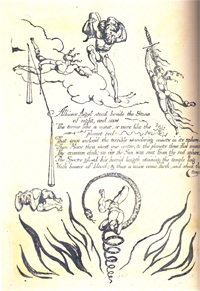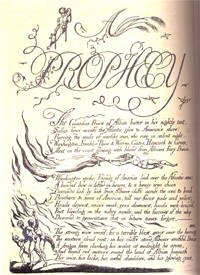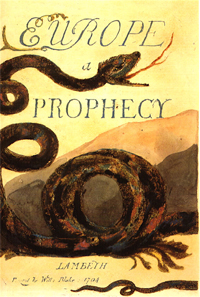|
That in plate 5 of William Blake’s AMERICA a PROPHECY, the figure clasped by Albion’s angel at the top of the engraving and, at the bottom, clutched upside down and headless in the coils of an encircling snake, is the king himself.

That Blake’s images make clear his attraction to the flex of power in violent struggles for liberty.
That in his visionary theology, an apocalyptic revolution of faith and values is imperative. In several manuscripts we see Blake representing revolutionary terror in terms of Christian apocalypse.
That Blake’s depictions of insurrections aren’t limited to his images. Many poems throb with violence, from outrage for the murdered “Little Boy Lost” in Songs of Innocence to the shout of “Pull down the tyrant to the dust” in “Gwin, King of Norway” to the description of “flames of Eternal fury” in The First Book of Urizen.
That there is a yet more subtle violence linked to Blake’s innovations as an artist.
That it is Blake’s re-visioning “hand or eye” which dares to frame a radical catachrestic symmetry in which images cross over into words and words into images.
That we know Blake rejected the Lockean convention that words are the arbitrary signs of ideas. That for Blake, words are living things. Blake’s ears “have heard,/ The Holy word,/ That walk’d among the ancient trees.”
That by focusing his attention on the phonetic, graphic, and etymological properties of words and by developing a novel technique for engraving words and images directly onto copper plates—a technique that treats words as images—Blake diminished distinctions between the linguistic and the pictorial.
That language and image rehearse as part of a singular performance in Blake’s engravings.
That if we look again at AMERICA a PROPHECY, we will see the A on the title page efflorescing into wheat sheaves. That in the last line of the first stanza, we will see the first stroke of the letter M in Meet dangling into the flame spewing from Albion’s sword. That we may note how this flourish is mirrored by the W in Washington, the first word in the next stanza.

That the letters are fuses lit by a “fire fierce glowing.” That Blake’s words are both denotative and performative.
That on the first plate of EUROPE a PROPHECY, the plumed serpent’s forked tongue is mirrored by the Y of PROPHECY as well as by the figuration extending from the R of EUROPE. That the serpent’s body loops in an unnatural way to from O’s that rhyme, visually, with the O’s (and C) in EUROPE a PROPHECY.

That equating spirit and letter, visualizing them in the same dimension, Blake noted to himself on the back of one drawing, “Angels to be very small as small as the letters.”
That violence is an act of possession.
That in Blake’s illuminated manuscripts, we see image seizing word to make it image. At the same time, word seizes image to make of it a letter. This more subtle violence in Blake’s art disarms the continuity of genre: printing and engraving, image and word collaborate in a communion of meaning, an adventure in possibilities.
* * *
It may be worthwhile at this moment in history to remember that Blake set out to yoke together word and image at a time when the difference had collapsed between attempting a violent act against the English king and imagining a violent act. Anyone could be hauled into court, tried, and imprisoned for merely thinking about violence, not to mention representing it.
It may be worthwhile to remember that Blake was in fact accused of sedition and tried. Sedition, in Blake’s time, included everything from criticism of the king to outright acts of terrorism.
* * *
In the 2007 post-Patriot Act United States, legal distinctions between acting violently and imagining a violent act once again have disappeared. Bush legislation has banned habeas corpus, legalized torture by Americans, and decriminalized it retroactively. Bush’s retromingent spray of dogma and crusaderism extinguishes the visionary impulses on which the United States was founded.
In Bush’s tenure, image has been torn away from word.
In William Blake’s work, violence is an expansive creative force. In George Bush’s policies, violence is absorptive. It absorbs freedom, subsuming it into its self-interested tar pit.
Blake’s violence collides with what restricts imagination; Bush’s violence collides with what lives.
In Blake’s visionary AMERICA a PROPHECY, words and images collaborate in an expansion of meaning and imagination. In Bush’s AMERICA a PROPHECY, the words and images cannot be linked.
|
|
|